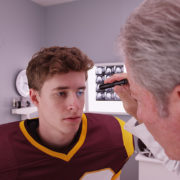What is CTE?
What is CTE?
What is CTE?
Chronic Traumatic Encephalopathy (CTE) is a progressive degenerative disease of the brain found in people with a history of repeated brain trauma.
The constant brain trauma triggers progressive degeneration of the brain tissue, including the build-up of an abnormal protein called tau.
These changes in the brain can begin months, years, or even decades after the last brain trauma.
How do you get CTE?
CTE includes both concussions that cause symptoms and subconcussive hits to the head that cause no symptoms.
CTE has been known to affect athletes in sports such as Football and Boxing.
At this time, the number or type of hits to the head needed to trigger degenerative changes to the brain is unknown.
Other factors such as genetics, may play a role in the development of CTE, because people without a history of repeated brain trauma can develop this disease.
What are the symptoms of CTE?
The symptoms of CTE include memory loss, confusion, impaired judgment, impulse control problems, aggression, depression, anxiety, suicidality, parkinsonism, and, eventually, progressive dementia.
These symptoms often begin years or decades after the last brain trauma.
How is CTE diagnosed?
Currently, CTE can only be diagnosed after death.
Researchers are working on finding biomarkers and other indicators to help detect it in the living, with further hope that such findings can help lead to potential treatments and a better understanding of CTE.
It is not clear how frequently people experience CTE related issues, but the risk of CTE is worrisome enough that it is important to focus on ways to reduce total overall exposure to repeated hits, such as limiting head-to-head contact.
Can CTE be cured? What can I do if I think I have CTE?
Unfortunately, there is no cure for CTE at this time.
Some of the symptoms of CTE like depression and anxiety, can be treated individually.
CTE develops early, soon after an injury, and it’s progressive.
If you believe you or a loved one may have CTE or other brain related injuries, please contact us.
The Pathways team of professionals has helped thousands of people with CTE and other brain related injuries. We are Dedicated to effective and compassionate care for individuals with neurological challenges.
The post What is CTE? appeared first on Pathways Neuropsychology Associates.
Source: Pathways Neuropsychology
What is CTE?












